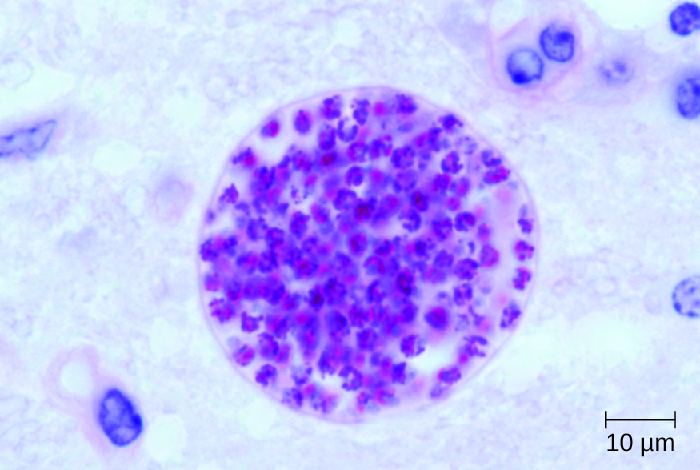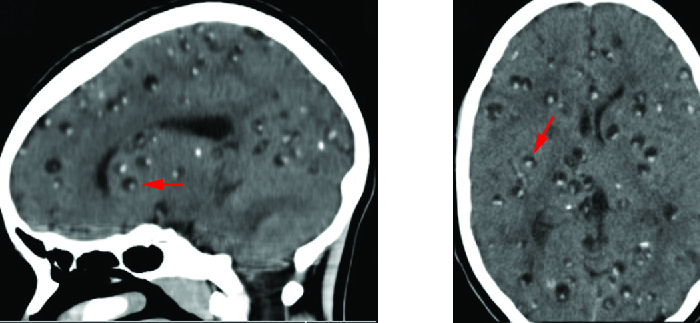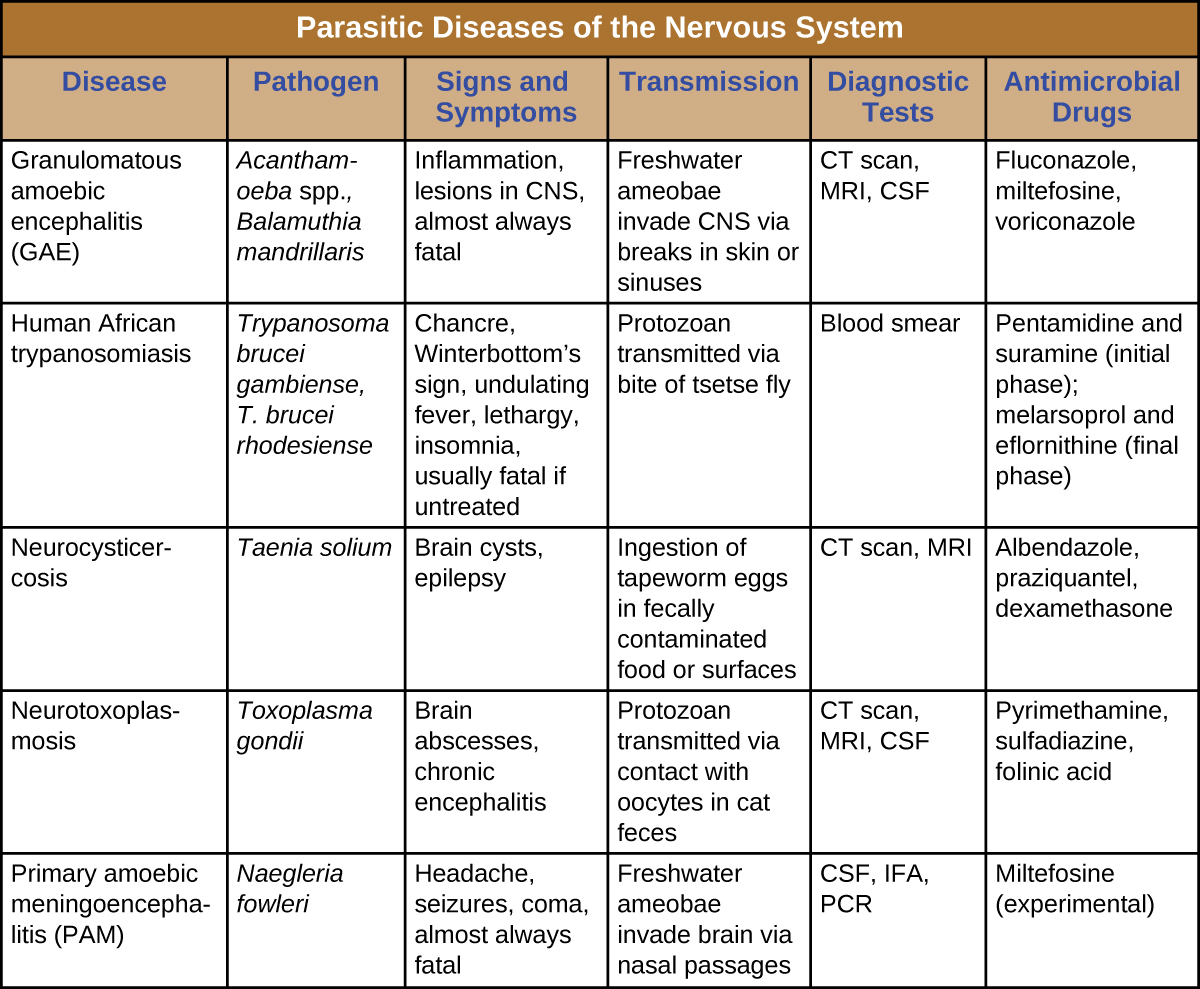| << Chapter < Page | Chapter >> Page > |
Toxoplasma gondii is an ubiquitous intracellular parasite that can cause neonatal infections. Cats are the definitive host, and humans can become infected after eating infected meat or, more commonly, by ingesting oocysts shed in the feces of cats (see Parasitic Infections of the Circulatory and Lymphatic Systems ). T. gondii enters the circulatory system by passing between the endothelial cells of blood vessels. Carruthers, Vern B., and Yasuhiro Suzuki, “Effects of Toxoplasma gondii Infection on the Brain,” Schizophrenia Bulletin 33, no. 3 (2007): 745-51. Most cases of toxoplasmosis are asymptomatic. However, in immunocompromised patients, neurotoxoplasmosis caused by T. gondii infections are one of the most common causes of brain abscesses. Uppal, Gulshan, “CNS Toxoplasmosis in HIV,” 2015. Accessed June 30, 2016. http://emedicine.medscape.com/article/1167298-overview#a3. The organism is able to cross the blood-brain barrier by infecting the endothelial cells of capillaries in the brain. The parasite reproduces within these cells, a step that appears to be necessary for entry to the brain, and then causes the endothelial cell to lyse, releasing the progeny into brain tissues. This mechanism is quite different than the method it uses to enter the bloodstream in the first place. Konradt, Christoph, Norikiyo Ueno, David A. Christian, Jonathan H. Delong, Gretchen Harms Pritchard, Jasmin Herz, David J. Bzik et al., “Endothelial Cells Are a Replicative Niche for Entry of Toxoplasma gondii to the Central Nervous System,” Nature Microbiology 1 (2016): 16001.
The brain lesions associated with neurotoxoplasmosis can be detected radiographically using MRI or CAT scans ( [link] ). Diagnosis can be confirmed by direct observation of the organism in CSF. RT-PCR assays can also be used to detect T. gondii through genetic markers.
Treatment of neurotoxoplasmosis caused by T. gondii infections requires six weeks of multi-drug therapy with pyrimethamine , sulfadiazine , and folinic acid . Long-term maintenance doses are often required to prevent recurrence.

Cysticercosis is a parasitic infection caused by the larval form of the pork tapeworm , Taenia solium . When the larvae invade the brain and spinal cord, the condition is referred to as neurocysticercosis . This condition affects millions of people worldwide and is the leading cause of adult onset epilepsy in the developing world. DeGiorgio, Christopher M., Marco T. Medina, Reyna Durón, Chi Zee, and Susan Pietsch Escueta, “Neurocysticercosis,” Epilepsy Currents 4, no. 3 (2004): 107-11.
The life cycle of T. solium is discussed in Helminthic Infections of the Gastrointestinal Tract . Following ingestion, the eggs hatch in the intestine to form larvae called cysticerci . Adult tapeworms form in the small intestine and produce eggs that are shed in the feces. These eggs can infect other individuals through fecal contamination of food or other surfaces. Eggs can also hatch within the intestine of the original patient and lead to an ongoing autoinfection. The cystercerci, can migrate to the blood and invade many tissues in the body, including the CNS.
Neurocysticercosis is usually diagnosed through noninvasive techniques. Epidemiological information can be used as an initial screen; cysticercosis is endemic in Central and South America, Africa, and Asia. Radiological imaging (MRI and CT scans) is the primary method used to diagnose neurocysticercosis; imaging can be used to detect the one- to two-centimeter cysts that form around the parasites ( [link] ). Elevated levels of eosinophils in the blood can also indicate a parasitic infection. EIA and ELISA are also used to detect antigens associated with the pathogen.

The treatment for neurocysticercosis depends on the location, number, size, and stage of cysticerci present. Antihelminthic chemotherapy includes albendazole and praziquantel . Because these drugs kill viable cysts, they may acutely increase symptoms by provoking an inflammatory response caused by the release of Taenia cysticerci antigens, as the cysts are destroyed by the drugs. To alleviate this response, corticosteroids that cross the blood-brain barrier (e.g., dexamethasone ) can be used to mitigate these effects. Surgical intervention may be required to remove intraventricular cysts.
Parasites that successfully invade the nervous system can cause a wide range of neurological signs and symptoms. Often, they inflict lesions that can be visualized through radiologic imaging. A number of these infections are fatal, but some can be treated (with varying levels of success) by antimicrobial drugs ( [link] ).

The ________ is the main virulence factor of Cryptococcus neoformans .
capsule
The drug of choice for fungal infections of the nervous system is ________.
Amphotericin B
The larval forms of a tapeworm are known as ________.
cysticerci
________ sign appears as swollen lymph nodes at the back of the neck in early African trypanosomiasis.
Winterbottom’s
________ African trypanosomiasis causes a chronic form of sleeping sickness.
West
Trypanosomes can evade the immune response through ________ variation.
antigenic
Why do nervous system infections by fungi require such long treatment times?
Briefly describe how humans are infected by Naegleria fowleri .
Briefly describe how humans can develop neurocysticercosis.

Notification Switch
Would you like to follow the 'Microbiology' conversation and receive update notifications?